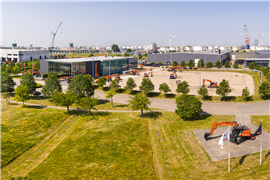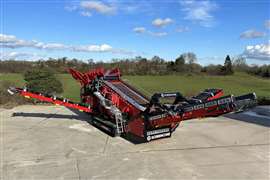Site report: Mann Group and the Melbourne Malt Silos
12 January 2022
The Malt Silos in Melbourne, Australia – once used to store grain for the local beer brewing industry – were a landmark for generations of the city’s population for almost 150 years.
That was until Major Australian National Award-winning Tier 1 Builder Probuilding Contractors asked Mann Group to demolish nine silos of around 45 m (147 ft) in height.
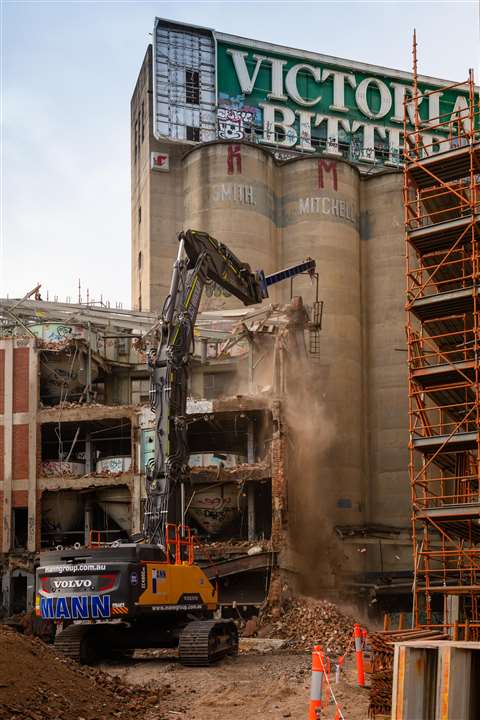 The Malt Silos had been a Melbourne icon for nearly 150 years
The Malt Silos had been a Melbourne icon for nearly 150 years
Based in Mount Waverley, Victoria, Mann Group workshopped and created a demolition methodology that it believes transformed the concept of traditional demolition, by pioneering the use of sophisticated demolition robots, custom made working platforms and anti-shock shelf angle brackets.
The project had a multitude of constraints, both environmental and commercial.
State regulated heritage consultants were one factor – part of the approval process was to ensure the remaining Heritage listed silos would not be damaged.
This involved extensive workshops with a state regulated body (Heritage Victoria) where Mann Group needed to show how its process would achieve this outcome.
World Demolition Award
It installed 24-hour vibration monitors on multiple locations within the heritage silos with a back to base and text messaging system that would notify the site team of any excessive movements. Mann then invited the Heritage team to nominate the vibration levels as well as be part of the notification system, which helped the company to meet their standards and achieved the approval to proceed.
It also had to collect 95,000 heritage bricks throughout the demolition have them cleaned, stacked, and stored in a secured location for future use in the new construction.
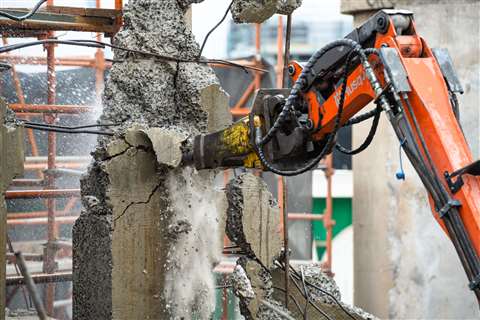 Husqvarna demolition robots in action on the project
Husqvarna demolition robots in action on the project
Traditional demolition would involve using large plant and long reach excavators, but this was not achievable as the local roads had weight restrictions and low-lying bridge underpasses, to such an extent that even if the excavators were to be dismantled and delivered in multiple sections, Mann still would be in breach of road limits.
The project was also located within 25 m (82 ft) of a major artery freeway bridge overpass, this created restraints with the Victoria roads authority as the visual impact could cause traffic congestion or accidents, the total encasement with scaffolding gave the road authority the satisfaction to approve working within such close vicinity.
In terms of environmental noise and dust concerns, due to the neighbouring residential properties Mann was tasked with mitigating the noise and dust that would be generated, so it had sporadic noise testing done around the site to ensure it did not exceed nominated decibels throughout the workdays and the demolition robots hand-picked for the job had an internal water suppression system, this keeps dust down to a minimum even on windy days.
The contract required Mann to absorb all inclement weather days within the programme. This included the demolition sequence being able to take into consideration the wind factor, being 45 m above ground the wind would have been a major issue for traditional demolition long reach excavators, the method used scaffold encapsulation, eliminating the wind factor as well as being able to compensate for rainy conditions. The robot operators had undercover protection from rain within the scaffold while the robots kept working thus eliminating direct harsh rain conditions to demolition operators.
Mann’s safety procedures
One of Mann’s major concerns is always employee safety weather using long reach excavators or small plant on suspended slabs. The risk factor is always high, so the best way to keep staff safe is to remove the risk completely.
The use of remote demolition robots eliminated the need for working near live edges and open shafts, the remote operators were able to safely operate from the scaffold while also keeping a 360° view of their surroundings.
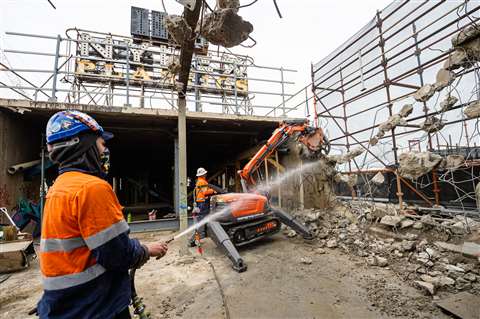 The demolition robots used on the project had their own water suppression system
The demolition robots used on the project had their own water suppression system
Engineering and approval bodies, due to the advanced method the engineering process was treated as paramount, we created the concept but now needed to ensure it was engineeringly possible, to ensure we meet industry standards including the company’s own industry expectations.
Engineering reviews were mandatory, and all engineering designs were reviewed and approved by a third-party firm not involved directly with the works, and this process was successful in working out all teething design concepts.
An industry requirement is to have all working boxes or crane boxes approved by WorkSafe Victoria (government safety authority).
Prior to manufacture the working platform design must receive approval. Mann now have a patented approved crane box design registered with its state government body.
All silos were surveyed to see if they were symmetrical, and Mann laser scanned all internal silos to ensure its platforms would all be one size. It also conducted non-destructive testing on the silo perimeter wall, to determine the compressive strength of the concrete, allowing its engineering department to workshop the sequence analysis for shelf angle load caring capacity.
Mann in Melbourne
To absorb any shock or impact loading forces rubber buffers were used when all shelf angles were installed. Pull testing was done on all threading rods to meet engineering standards.
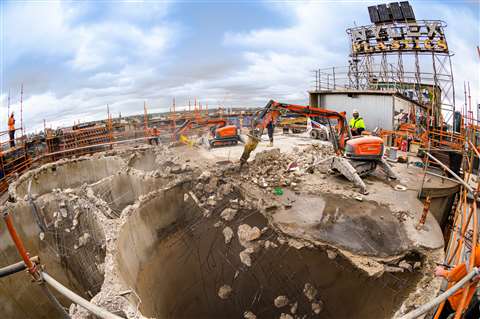 Mann Group was asked to demolish nine silos each around 45 metres high
Mann Group was asked to demolish nine silos each around 45 metres high
To ensure the company were up to date and had every option available in case of emergency, it invited the state authority fire department to be part of the workshop process. The authority ran drills through local traffic and different options for a rescue situation, abseiling being the main conclusion. This input helped point out some amendments that needed to be solved. To make sure all access points though scaffold and penetrations in the silo walls for platform access were wide enough for a stretcher, Mann also nominated a dedicated spot on the site for emergency services vehicles to be always keep clear.
Due to the demolition method being unprecedented, the company set up a to scale model mark up in its compound and had the robot operators run sequences. This also helped with subcontractors, enabling them to play out their works and look for any kinks that may arise.
Part of the contract requirements was to keep the programme duration the same as traditional demolition – using long reach – once the above restrictions were workshopped and all stakeholders had been satisfied the programme was the final hurdle. By playing out multiple sequences, Mann concluded that a total of three working platforms should be made with the two demolition robots working on a “Leapfrog” sequence.
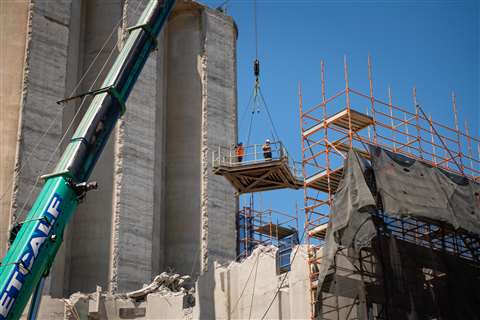 A feature of the Malt Silos project was special conditions relating to working platforms and crane boxes
A feature of the Malt Silos project was special conditions relating to working platforms and crane boxes
Part of the programme constraints was to figure out how and when to remove the rubble without slowing or stopping the demolition activities. This was done by running engineering computations to ensure the rubble could accumulate within each silo safely without excessive build-up of rubble material. Including the bulking factor, the rubble built up to the 10 m (32 ft) mark. Once Mann reached the 12 m (39 ft) mark with robot demolition, it then diverted back to traditional demolition and completed the remaining 12 m silo sections and truck load out with large excavators.
In conclusion, Mann delivered a project on time, on budget, with up to 99% recycling rate. Its site team along with the subcontractors recorded zero incidents, and this was a huge achievement for all stakeholders involved in the project.
CONNECT WITH THE TEAM







